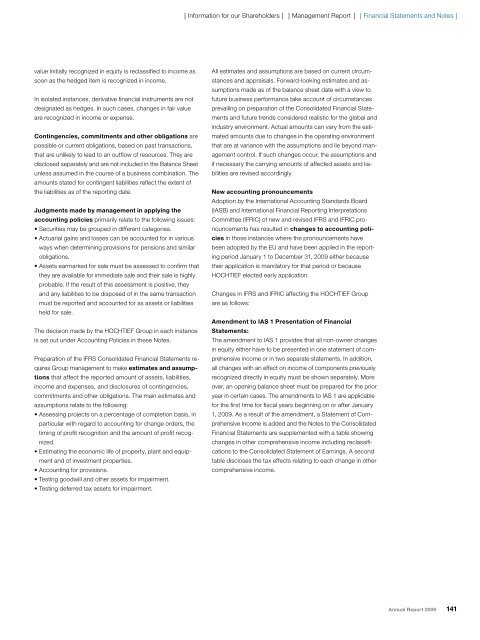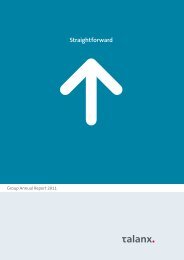ONE ROOF
ONE ROOF
ONE ROOF
You also want an ePaper? Increase the reach of your titles
YUMPU automatically turns print PDFs into web optimized ePapers that Google loves.
value initially recognized in equity is reclassified to income as<br />
soon as the hedged item is recognized in income.<br />
In isolated instances, derivative financial instruments are not<br />
designated as hedges. In such cases, changes in fair value<br />
are recognized in income or expense.<br />
Contingencies, commitments and other obligations are<br />
possible or current obligations, based on past transactions,<br />
that are unlikely to lead to an outflow of resources. They are<br />
disclosed separately and are not included in the Balance Sheet<br />
unless assumed in the course of a business combination. The<br />
amounts stated for contingent liabilities reflect the extent of<br />
the liabilities as of the reporting date.<br />
Judgments made by management in applying the<br />
accounting policies primarily relate to the following issues:<br />
• Securities may be grouped in different categories.<br />
• Actuarial gains and losses can be accounted for in various<br />
ways when determining provisions for pensions and similar<br />
obligations.<br />
• Assets earmarked for sale must be assessed to confirm that<br />
they are available for immediate sale and their sale is highly<br />
probable. If the result of this assessment is positive, they<br />
and any liabilities to be disposed of in the same transaction<br />
must be reported and accounted for as assets or liabilities<br />
held for sale.<br />
The decision made by the HOCHTIEF Group in each instance<br />
is set out under Accounting Policies in these Notes.<br />
Preparation of the IFRS Consolidated Financial Statements re-<br />
quires Group management to make estimates and assump-<br />
tions that affect the reported amount of assets, liabilities,<br />
income and expenses, and disclosures of contingencies,<br />
commitments and other obligations. The main estimates and<br />
assumptions relate to the following:<br />
• Assessing projects on a percentage of completion basis, in<br />
particular with regard to accounting for change orders, the<br />
timing of profit recognition and the amount of profit recognized.<br />
• Estimating the economic life of property, plant and equipment<br />
and of investment properties.<br />
• Accounting for provisions.<br />
• Testing goodwill and other assets for impairment.<br />
• Testing deferred tax assets for impairment.<br />
❘ Information for our Shareholders ❘ ❘ Management Report ❘ ❘ Financial Statements and Notes ❘<br />
All estimates and assumptions are based on current circumstances<br />
and appraisals. Forward-looking estimates and assumptions<br />
made as of the balance sheet date with a view to<br />
future business performance take account of circumstances<br />
prevailing on preparation of the Consolidated Financial Statements<br />
and future trends considered realistic for the global and<br />
industry environment. Actual amounts can vary from the estimated<br />
amounts due to changes in the operating environment<br />
that are at variance with the assumptions and lie beyond management<br />
control. If such changes occur, the assumptions and<br />
if necessary the carrying amounts of affected assets and liabilities<br />
are revised accordingly.<br />
New accounting pronouncements<br />
Adoption by the International Accounting Standards Board<br />
(IASB) and International Financial Reporting Interpretations<br />
Committee (IFRIC) of new and revised IFRS and IFRIC pronouncements<br />
has resulted in changes to accounting policies<br />
in those instances where the pronouncements have<br />
been adopted by the EU and have been applied in the reporting<br />
period January 1 to December 31, 2009 either because<br />
their application is mandatory for that period or because<br />
HOCHTIEF elected early application.<br />
Changes in IFRS and IFRIC affecting the HOCHTIEF Group<br />
are as follows:<br />
Amendment to IAS 1 Presentation of Financial<br />
Statements:<br />
The amendment to IAS 1 provides that all non-owner changes<br />
in equity either have to be presented in one statement of comprehensive<br />
income or in two separate statements. In addition,<br />
all changes with an effect on income of components previously<br />
recognized directly in equity must be shown separately. More<br />
over, an opening balance sheet must be prepared for the prior<br />
year in certain cases. The amendments to IAS 1 are applicable<br />
for the first time for fiscal years beginning on or after January<br />
1, 2009. As a result of the amendment, a Statement of Comprehensive<br />
Income is added and the Notes to the Consolidated<br />
Financial Statements are supplemented with a table showing<br />
changes in other comprehensive income including reclassifications<br />
to the Consolidated Statement of Earnings. A second<br />
table discloses the tax effects relating to each change in other<br />
comprehensive income.<br />
Annual Report 2009 141
















